Australia So Much to See




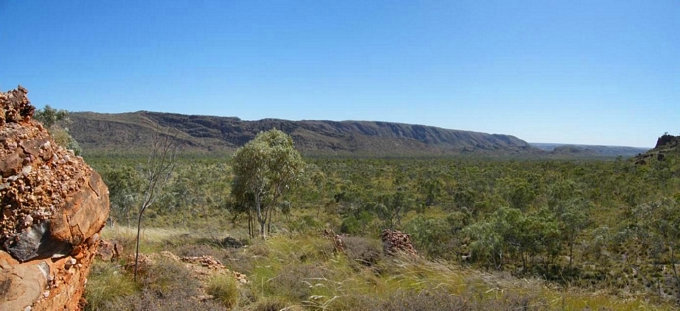
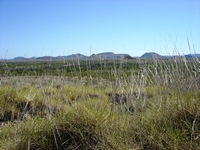
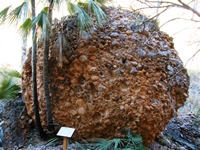
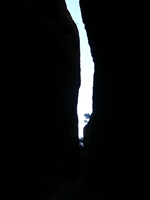
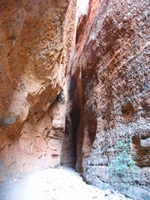
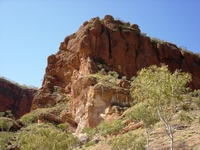
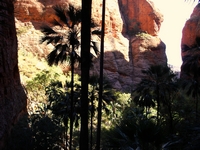
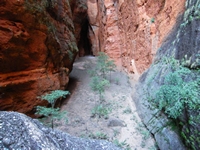
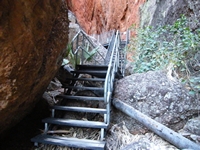
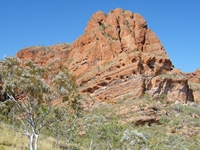
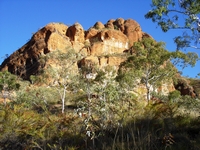

Bungle Bungle Range 2008 Purnululu National
Park
A change of plans took us to Purnululu from Kununurra, rather than from Halls Creek as was our original intention. This proved
to be a good move, because the road from the junction of the Great Northern Highway (to Wyndham) and the Victoria Highway (to Kununurra)
heading south was a pleasant and scenic drive with rugged red ranges on either side of the road which would have missed seeing. Bridgeworks and road re-alignments were in progress, making this section of the highway even better. Many of the single
lane bridges are being replaced. As road trains are frequent, they announce approaching the narrow bridges on UHF two way radio
so other traffic can give way.
After turning off onto the
The rock faces in the northern section are very different to the banded domes in the southern section of the park.
After camping for the night at the Kurrajong campsite towards the northern part of the range, we returned to the Osmand Lookout next
morning to have the sun behind us as we looked across the Red Rock Creek valley to the
The domes were originally layers of sediments that have formed the sandstone 350 million years ago; some containing cyanobacteria
(one of the earliest forms of life) and some containing iron oxide.
Erosion has carved the dome like shapes, with
the continuity of the parallel bands of colour showing that they were once part of one huge slab of sandstone.
Cyanobacteria
grew on the layers with high clay content and moisture retention and on the surface show as a dark grey colour. Layers with
lower clay content dried out quicker which impeded the growth of the bacteria. Iron oxide on the surface has weathered to a
rusty colour.
Purnululu has always been known as a special place by the local Aborigines. The Aboriginal name of Purnululu means sandstone. When pastoralists opened up stations in the area, this rocky area was considered worthless land. It was only in 1983 that
the world was shown what an amazing place it is. In 1987 it was declared a National Park, and in 2003 placed on the Word Heritage
register.
Walk trails have been made to strategic points and, apart from exploring Piccaninny Creek, public access is
limited to these marked walk trails. Helicopter rides can be taken over the massif to see the full extent.
Purnululu
can be very cold at night in winter, sometimes below freezing, while most days will be hot. In summer, day time temperatures
above 50 degrees centigrade can occur.
The origin of the name Bungle Bungle is obscure and there are several theories
as to why a nearby station was given this name. The massif was named Bungle Bungle after this station in 1983.
Steps have been constructed in strategic places to make the walk easier as we climb into the gorge.
After paying our fees at the visitor centre, we entered the National Park, first stopping at the Kungkalanayi Lookout which gives
good panoramic vistas of the western face of the Bungle Bungle massif in the afternoon sun. Seats are provided on the crest
of a ridge, making it an ideal sunset viewing point.
Looking north and west from the Kungkalanayi lookout, there are spinifex plains and further hills which we crossed when entering the
park.
We headed to the northern section of the park, where bands contain conglomerate of stones between the clay layers with rock formations
are very different to the traditional Bungle Bungle dome shapes of the southern section.
We took the walk into Echidna Chasm. Near midday sunlight shines through the narrow clefts. It was cool and shady, with
some very narrow passages through the fascinating 200 metre long chasm.
From a viewing platform at the top of a flight of steps, we look down into an Amphitheatre area of the gorge. To climb down
into this would be difficult and this platform is the end of the marked trail and authorised access.
This large piece of rock near Echidna Chasm shows the size of the stones in the conglomerate rocks of the northern part of Purnululu.
There were some narrow sections where rock falls had almost blocked the passage and climbing through required agility. One well
built lady became firmly wedged between the rocks and needed help to go back. She was unable to continue the trail through the
chasm.
Further towards the south west, dust can be seen on the Spring Creek track; the only public access to
For an overview of Purnululu National Park open the link then click on Media Tab for a video flight across the Bungle Bungle Range and a look at some of the walks within the range. This video may no longer be available, however the link below is.
Take
a long flight over Purnululu from Youtube.
Superceded: Please note that the Bungle Bungle Caravan Park will not be opening as planned on the 1st of May 2023 while negotiations are made with native title holders. Time frame unknown at present and booking are not being taken for the 2024 season at this stage. This also applies to all tours and helicopter flights from this venue. See Bungle Bungle Caravan Park and Tour Company for updates as they become known.